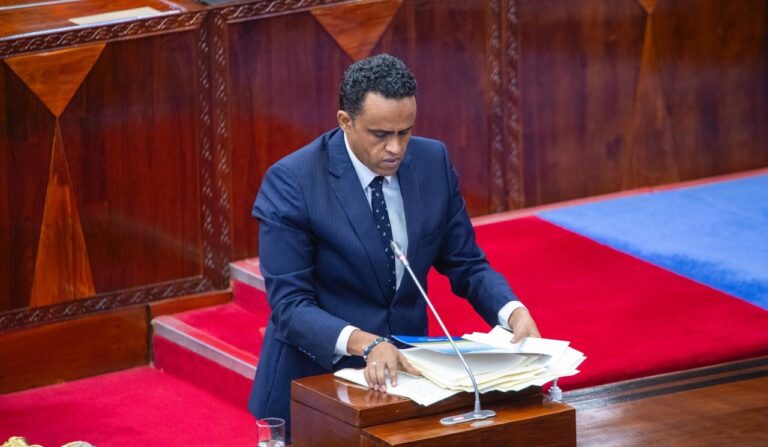Dodoma. Tanzania’s agriculture sector has experienced a historic transformation under the leadership of President Samia Suluhu Hassan, with budgetary allocations, productivity levels, and exports reaching unprecedented milestones.
Tabling the 2025/26 agriculture budget estimates in Parliament on May 21, 2025 as he requested Parliament to approve a total of Sh1.24 trillion for the 2025/26 financial year, the minister of Agriculture, Hussein Bashe, underscored a four-year journey marked by exponential investment and robust sectoral performance.
He said the largest achievement is the sustained increase in the agriculture budget from Sh294 billion in the 2021/22 financial year to Sh1.248 trillion in 2024/25—equivalent to a 324.49 percent rise over four years.
“These investments are not cosmetic,” said Mr Bashe. “They reflect the government’s clear commitment to making agriculture a modern, productive, and sustainable economic pillar.”
Robust Sectoral Growth and Ambitious Targets
The agriculture sector grew by 4.2 percent in 2023, up from 2.6 percent in 2021.
The government now targets 5 percent growth in 2025 and an ambitious 10 percent by 2030.
Agriculture contributed 26.3 percent to the national GDP in 2024, surpassing the target of 23.4 percent, while also employing 61.4 percent of the national workforce—above the 60 percent benchmark.
Crop production specifically registered 4.0 percent growth in 2024, compared to the 5.7 percent target, and accounted for 16.1 percent of GDP contribution from agriculture.
Surging Food Production and Self-Sufficiency
Tanzania’s food crop production rose sharply from 17.1 million tonnes in 2021/22 to 22.8 million tonnes in 2023/24, marking a 33 percent increase.
This growth translated into a national food self-sufficiency level of 128 percent—close to the 130 percent target.
Maize production surged from 6.4 million tonnes in the 2021/22 season to 12.26 million tonnes in 2023/24, representing a 91.06 percent increase.
This feat has positioned Tanzania as the second-largest maize producer in Africa. Likewise, rice production increased by 72.27 percent—from 1.77 million tonnes in 2020/21 to over 3.04 million tonnes in 2023/24.
Export Boom in Cash and Horticultural Crops
Export earnings from agricultural produce also recorded significant gains.
The value of exported agricultural crops climbed from $1.2 billion in 2019/20 to $3.54 billion in 2023/24—an increase of 195 percent.
Production of traditional cash crops improved markedly. Overall, production jumped by 61.5 percent, from 898,967 tonnes in 2020/21 to 1.45 million tonnes in 2023/24.
Cashew nuts rose dramatically by 150.61 percent, from 210,786 tonnes in 2020/21 to over 528,263 tonnes in 2024/25.
Tobacco production tripled by 173.47 percent, from 58,508 tonnes to 160,000 tonnes, elevating Tanzania to the second-highest tobacco producer in Africa.
Sugarcane output grew from 3.88 million tonnes (producing 367,718 tonnes of sugar) in 2020/21 to 4.71 million tonnes (yielding 431,736 tonnes of sugar) in 2024/25—a 17.41 percent increase.
This is 61.68 percent of the national target of producing 700,000 tonnes of sugar.
Sisal production grew by 69.24 percent from 36,170 tonnes in 2020/21 to 61,215 tonnes in 2024/25, while coffee output climbed by 37.17 percent to 81,366 tonnes—ranking Tanzania fourth in Africa.
Horticultural crop output reached 7.5 million tonnes in 2023/24, up from 7.3 million tonnes in 2020/21, driven by increased avocado production.
Avocado exports rose from 26,826 tonnes valued at Sh117.5 billion in 2022/23 to 35,627 tonnes valued at Sh252.3 billion in 2023/24.
Oilseeds and Seed Multiplication
Oilseed crop production grew from 1.71 million tonnes in 2020/21 to 2.14 million tonnes in 2023/24—a 25.1 percent rise.
Sunflower output more than doubled, from 478,900 tonnes in 2020/21 to 1.22 million tonnes in 2023/24, representing a 154.13 percent increase.
Local seed production has improved remarkably. The country produced 63,526.54 tonnes of improved seeds in 2024/25, more than double the 30,167 tonnes produced in 2020/21.
As a result, the availability of quality seeds increased by 78.78 percent—from 44,581 tonnes to 79,700 tonnes during the period.
Fertiliser Manufacturing and Usage on the Rise
The domestic fertiliser manufacturing capacity has grown from 32,239 tonnes in 2020/21 to 158,628 tonnes in 2024/25—a 392 percent increase.
This leap is credited to the establishment of the ITRACOM fertiliser plant in Dodoma, with a capacity of one million tonnes per annum, and the expansion of Minjingu Fertiliser Company from 30,000 to 100,000 tonnes annually.
As a result, national fertiliser availability rose from 678,017 tonnes in 2020/21 to 1.21 million tonnes in 2024/25—a 79 percent increase.
Over the past three years, the Ministry facilitated a fertiliser subsidy programme that delivered 1.45 million tonnes of fertiliser worth Sh708.6 billion.
Consequently, fertiliser usage surged from 363,599 tonnes in 2021/22 to 848,884 tonnes in 2023/24—a 133.47 percent increase.
Fertiliser application per hectare rose from 19kg in 2021/22 to 24kg in 2024/25—representing 48 percent of the CAADP target of 50kg per hectare.
Investment in Irrigation Infrastructure
One of the most transformative achievements under President Samia’s administration is the expansion of irrigation infrastructure.
The number of irrigation projects grew from just 13 in 2020/21 to 780 in 2024/25. These projects cover a total of 543,366 hectares and cost Sh1.34 trillion to implement.
Upon completion, they will raise the total irrigated area to 1.27 million hectares.
The number of registered Irrigation Organisations has increased from 19 in 2020/21 to 912 in 2024/25, in accordance with the National Irrigation Act No. 4 of 2013.
To strengthen irrigation development, the government established 121 district offices, hired 344 technical staff, and procured essential tools including 30 earth-moving machines, 17 heavy-duty vehicles, 18 water well drilling rigs, and 58 smaller vehicles for supervision and monitoring.
Strengthening Food Security through Strategic Reserves
To secure national food reserves, the government enhanced the capacity of the National Food Reserve Agency (NFRA) from 251,000 tonnes in 2020/21 to 776,000 tonnes in 2024/25—an increase of 209.16 percent. This initiative is part of a broader plan to mitigate shocks and ensure availability of food during emergencies.







